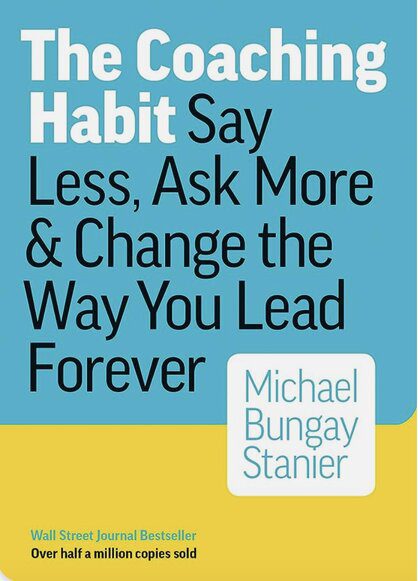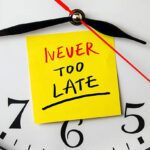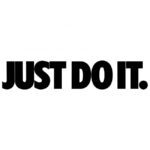A little more asking people questions and a little less telling people what to do.
In The Coaching Habit: Say Less, Ask More & Change the Way You Lead Forever, author and speaker Michael Bungay Stanier describes seven essential questions for becoming a better coach. Stanier advocates staying curious a little longer and asking more questions as a tool for coaching.
The real secret sauce here is building a habit of curiosity. The change of behaviour that’s going to serve you most powerfully is simply this: a little less advice, a little more curiosity. Find your own questions, find your own voice. And above all, build your own coaching habit.
Self Evident Coaching
Coaching is simple. In fact, this book’s Seven Essential Questions give you most of what you need. You can coach someone in ten minutes or less. And in today’s busy world, you have to be able to coach in ten minutes or less. Coaching should be a daily, informal act, not an occasional, formal “It’s Coaching Time!” event.
You can build a coaching habit, but only if you understand and use the proven mechanics of building and embedding new habits.
Breaking out of the three vicious circles
Circle #1: Creating Overdependence
The more you help your people, the more they seem to need your help. The more they need your help, the more time you spend helping them.
Building a coaching habit will help your team be more self-sufficient by increasing their autonomy and sense of mastery and by reducing your need to jump in, take over and become the bottleneck.
Circle #2: Getting Overwhelmed
The more you lose focus, the more overwhelmed you feel. The more overwhelmed you feel, the more you lose focus.
Building a coaching habit will help you regain focus so you and your team can do the work that has real impact and so you can direct your time, energy and resources to solving the challenges that make a difference.”
Circle #3: Becoming Disconnected
The more we do work that has no real purpose, the less engaged and motivated we are. The less engaged we are, the less likely we are to find and create Great Work.”
Building a coaching habit will help you and your team reconnect to the work that not only has impact but has meaning as well. Coaching can fuel the courage to step out beyond the comfortable and familiar, can help people learn from their experiences and can literally and metaphorically increase and help fulfil a person’s potential.
To build an effective new habit, you need five essential components: a reason, a trigger, a micro-habit, effective practice, and a plan.
The New Habit Formula
There are three parts to the formula: identifying the trigger, identifying the old habit and defining the new behaviour.
Identifying the Trigger: When This Happens…
Define the trigger, the moment when you’re at a crossroads and could go down either the well-trod road of the old way of behaving or the Robert Frost path less trodden. If you don’t know what this moment is, you’re going to continually miss it and, with that, the opportunity to change your behaviour.
Identifying the Old Habit: Instead Of…
Articulate the old habit, so you know what you’re trying to stop doing. Again, the more specific you can make it, the more useful it’s going to be.
Defining the New Behaviour: I Will…
Define the new behaviour, one that will take sixty seconds or less to do.
New Habit
“Ask one question at a time. Just one question at a time.
- The Kickstart Question: “What’s on Your Mind?
An almost fail-safe way to start a chat that quickly turns into a real conversation is the question, “What’s on your mind?” It’s something of a Goldilocks question, walking a fine line so it is neither too open and broad nor too narrow and confining.
Because it’s open, it invites people to get to the heart of the matter and share what’s most important to them. You’re not telling them or guiding them. You’re showing them the trust and granting them the autonomy to make the choice for themselves.
It’s a question that says, Let’s talk about the thing that matters most.
Coaching for Performance vs. Coaching for Development
Coaching for performance is about addressing and fixing a specific problem or challenge. It’s putting out the fire or building up the fire or banking the fire. It’s everyday stuff, and it’s important and necessary.
Coaching for development is about turning the focus from the issue to the person dealing with the issue, the person who’s managing the fire. This conversation is more rare and significantly more powerful.
2: The AWE Question: “And What Else?
With seemingly no effort, it creates more—more wisdom, more insights, more self-awareness, more possibilities—out of thin air.
There are three reasons it has the impact that it does: more options can lead to better decisions; you rein yourself in; and you buy yourself time.
When you use “And what else?” you’ll get more options and often better options. Better options lead to better decisions. Better decisions lead to greater success.
Tell less and ask more. Your advice is not as good As you think it is.
The Advice Monster
We’ve all got a deeply ingrained habit of slipping into the advice-giver/expert/answer-it/solve-it/fix-it mode. That’s no surprise, of course. When you take the premium that your organization places on answers and certainty, then blend in the increased sense of overwhelm and uncertainty and anxiety that many of us feel as our jobs and lives become more complex, and then realize that our brains are wired to have a strong preference for clarity and certainty, it’s no wonder that we like to give advice. Even if it’s the wrong advice—and it often is—giving it feels more comfortable than the ambiguity of asking a question.
“A much-quoted 1984 study by Howard Beckman and Richard Frankel found that the average time to interruption for doctors was eighteen seconds. ”
3: The Focus Question: What’s the Real Challenge Here for You?
When people start talking to you about the challenge at hand, what’s essential to remember is that what they’re laying out for you is rarely the actual problem. And when you start jumping in to fix things, things go off the rails in three ways: you work on the wrong problem; you do the work your team should be doing; and the work doesn’t get done.
“Focus on the real problem, not the first problem.”
Coaching vs Gossiping
The key thing to know here is that you can coach only the person in front of you. As tempting as it is to talk about a “third point” (most commonly another person, but it can also be a project or a situation), you need to uncover the challenge for the person to whom you’re talking.
“Stick to questions starting with “What” and avoid questions starting with “Why.” ”
4: The Foundation Question: “What Do You Want?
In which the question that lies at the very heart of adult-to-adult relationships is discussed. Block defined an adult-to-adult relationship as one in which you are “able to ask for what you want, knowing that the answer may be No.
5: The Lazy Question: How Can I Help?
The power of “How can I help?” is twofold. First, you’re forcing your colleague to make a direct and clear request. That may be useful to him. He might not be entirely sure why he started this conversation with you. Sure, he knows he wants something, but until you asked the question, he didn’t know that he wasn’t exactly clear on what he wanted.
The more direct version of “How can I help?” is “What do you want from me?”
6. The Strategic Question: If You’re Saying Yes to This, What Are You Saying No To?
To begin with, you’re asking people to be clear and committed to their Yes. But a Yes is nothing without the No that gives it boundaries and form.
7. The Learning Question: What Was Most Useful for You?
People don’t really learn when you tell them something. They don’t even really learn when they do something. They start learning, start creating new neural pathways, only when they have a chance to recall and reflect on what just happened.
Use Every Channel to Ask a Question
The real secret sauce here is building a habit of curiosity. The change of behaviour that’s going to serve you most powerfully is simply this: a little less advice, a little more curiosity. Find your own questions, find your own voice. And above all, build your own coaching habit.
All the best in your quest to get better. Don’t Settle: Live with Passion.



Comments are closed.